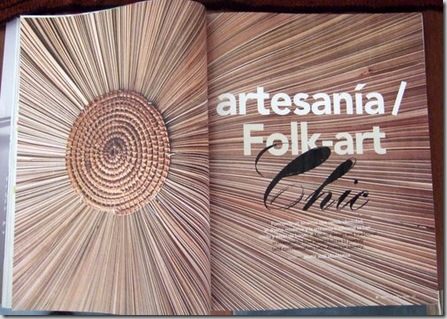The adventure for craft in the University of Valparaiso continues in 2008. Last year, I witnessed the design students attempt to develop product out of a remote stony Chilean village at the end of the road called Pedernal. This year, their enterprising teacher Patty Gunther takes them to La Ligua, a centre for handmade textiles.
The students are working on a project managed by Claudia Cajtak called Wanaku. The project emerges indirectly from one of the main industries in the area, turkey farming. The company Sopraval has sponsored the project to make something of the small stock of Guanacos, which produce a fur excellent for spinning and weaving.
La Ligua is famous for a number of unique features. As a textile centre, it specialises in handmade jumpers, which you can see hanging from the front of houses. All the weavers are male. The women specialise in sweets, and a characteristic feature of the town is the palomita (little dove), a woman dressed in a white apron waving a white flag advertising the tooth-shattering confections.
The visit to La Ligua was carefully choreographed. We started by meeting the source of project at the Guanaca farm. Along with us was a local spinner Ondina de Carmen. Despite working with the fibre all her life, she had never actually seen a guanaca in reality. She brought her three
daughters along and the family seemed thrilled with the
experience. Ondina then demonstrated how to spin the fibre, using a very crude spindle weighted with a steel nut and rotating on a broken ceramic plate. The students seemed completely fascinated by this exercise in craft magic, though only one young girl was brave enough to try it out herself.
We then visited the home of one of the weavers. The man’s looms were located in his backyard under a crude shelter with lumpy mud floors. They looked crudely constructed, but appeared to work very well. Elsewhere in the garden, the fig tree was in full fruit attracting swarms of bees. The scene was echoed by us city-dwellers, with our little silver boxes, swarming over the rich material scene, gathering up raw substance for our cameras. The scene offered an unmediated world that seemed totally innocent of design. So what might design make of this?
Talking with the manager, Claudia Cajtak, it is clear that Wanaku is not a simple exercise. Though the local participants seem very keen and excited to be part of it, it may not be so easy to convince the rest of the population, which is fraught with small town rivalries.
So what should the students offer as a way of developing the rich potential of this area? What kind of compromise will be necessary to help preserve and strengthen the local culture? Time will tell, but it moves slowly in La Ligua.





